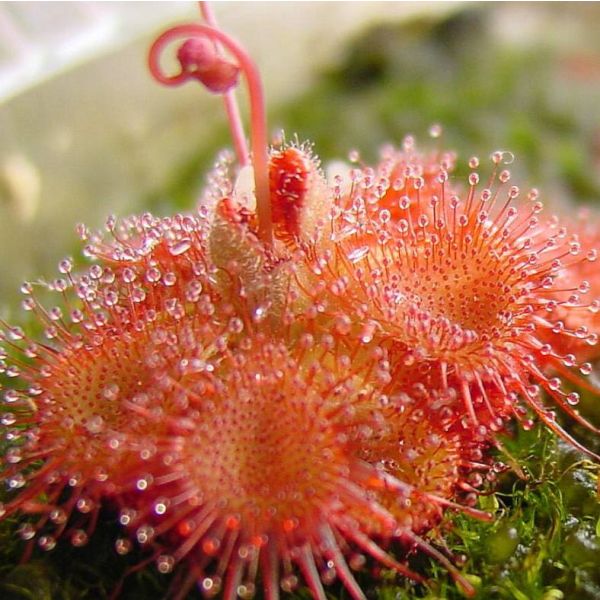Drosera Sessilifolia Seeds (South American)
Drosera Sessilifolia Seeds (South American)
Seeds from Northen Brazil Coast. Although Drosera sessilifolia is one of the most widespread Drosera in South America, it?s frustratingly rare, occurring in very specific and restricted habitats.

Delivery
All orders shipped with UPS Express.
Always free shipping for orders over US $250.
All orders are shipped with a UPS tracking number.
Returns
Items returned within 14 days of their original shipment date in same as new condition will be eligible for a full refund or store credit.
Refunds will be charged back to the original form of payment used for purchase.
Customer is responsible for shipping charges when making returns and shipping/handling fees of original purchase is non-refundable.
All sale items are final purchases.
Help
Give us a shout if you have any other questions and/or concerns.
Email: contact@domain.com
Phone: +1 (23) 456 789
Availability: Out of stock
SKU
Drosera Sessilifolia
Known to occur from Northern Venezuela to Southwestern Brazil, Drosera sessilifolia is the second most widespread Drosera species in South America. An annual related to the very similar Australian Drosera burmannii, with which it freely hybridises to form the unusually fertile hybrid Drosera thelocalyxiana.
Although Drosera sessilifolia is one of the most widespread Drosera in South America, it?s frustratingly rare, occurring in very specific and restricted habitats. It?s also an annual and extremely difficult to catch during its brief flowering period. It will only open its flowers for a few hours in the morning, but like its close cousin Drosera burmannii, from which it is nearly indistinguishable, it?s exasperatingly shy to flower, hardly opening up its petals completely. The leaves of Drosera burmannii are more triangular and those of Drosera sessilifolia more rounded.
The leaves form a rosette lying flat upon damp soil. The rosette is about 4 cm across and the leaves are spoon-shaped. In full sunlight, the plants turn red. You'll see erect scapes with pink flowers in the Summer which bear copious quantities of seeds.
The visiting insects are attracted to the leaves by the glistening tips of the hairs. The leaves, curl around any captured prey like a fist. Once caught the insect is digested by the sticky digestive fluid poured out by the plant. This unique way of obtaining nitrogenous food enables these plants to live in soils poor in available nitrogen.
Hardiness zones 7-10, (1øC/35øF, -15øC/5øF) in Winter. Grow in bright light. You can use a mix of one part peat moss for one part sand. In cultivation Drosera Sessilifolia is always a glimmer of what it is in the wild, remaining tiny in all aspects. In nature, they grow in small populations not too far from the road , where there is some cows and horses. Maybe they?re dependent on more fertile patches of soils. So, in cultivation, you may try to fertilize them.
Requires consistently moist soil; do not let dry out between waterings. Water must be distilled or rain water because they do not tolerate city or hard water. It is a good idea to place a pie pan or large saucer, with about an inch of water in it, under the pot. Elevate the pot by placing pebbles under it so that the base of the pot is barely in contact with the water, not submerged; the growing medium must stay moist, but never soggy. This will keep the humidity around the plant higher and it will ensure that the plant has a constant source of moisture. The humidity should be between 60-80%.
| Common name | Sundew |
|---|---|
| Species | Drosera sessilifolia |
| Germination | The seeds require 6 weeks hot stratification. Sow directly on the surface of your moist but not soaked soil mix. Do not cover them with any medium, the seeds are really tiny. After hot stratification, somewhat uncover the top of the pot, so that moisture and heat drop a little. Place the pot in an area with real nice strong light and keep the temperature around 20øC/68øF. When you see some tiny plants starting to sprout, slowly open the top of the pot, a little each day, so that the new seedlings don't go into shock from the humidity being lowered too quickly. After hot stratification, germination usually occurs in 1-3 months, but it can be prolonged up to several months, depending on their degree of unbroken dormancy, don't give up. Be very gentle with the new seedlings, not to destroy anything, it is very tiny. Make sure that it gets good air circulation. |
| Scarification / Stratification | It creates a hot and moist environment for the seeds. This will break their dormancy. Place the seeds on top of a prepared soil mix. Put the pots with seeds in plastic ziplock bags under but not too close to florescent lights. A temperature around 25øC / 76øF works best. Make sure to check the seeds often. If fungus or mold appears treat it with a fungicide. |
| Price View | Price Range |

